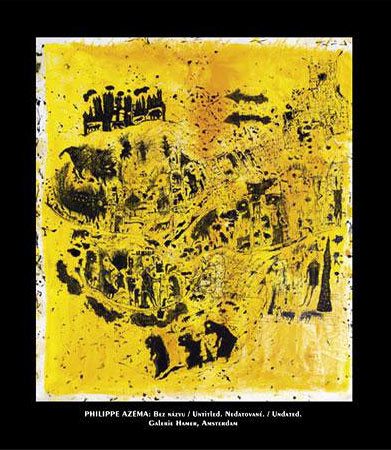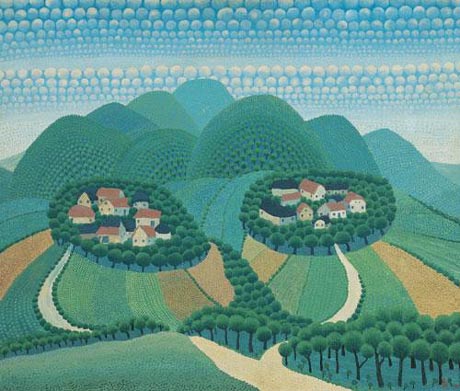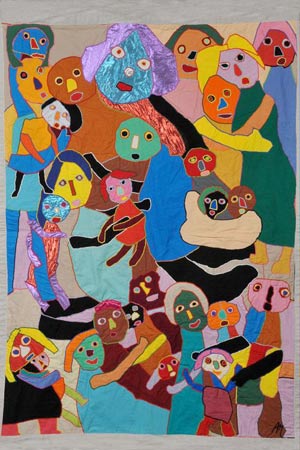INSITA 2010 – 9th Triennial of Self-Taught Art in Bratislava

The international triennial show INSITA is a selective art exhibition, the only event of its in the international context. It presents authentic values of self-taught art – Naive Art, Art Brut (the term coined by Jean Dubuffet for so-called raw art) and Outsider Art (the term coined by Roger Cardinal for non-conformist art, not subject to conventional and fashion culture).
Every one of the eighty-six artists represented at INSITA 2010, which follows the programme and conception of the previous exhibitions, is different and unique. The differences in the expression of form and subject arise from the artists’ characters, lifestyles, and domestic environment. The artists represent different generations, education and walks of life. While artistic creation helps some of them overcome loneliness or disappointment, the work of other practitioners springs from the joy of creation.
Slovak National Gallery, Bratislava, Esterhazy Palace, 1st floor, basement
Duration of exhibition : 3 July 2010 - 26 September 2010
Exhibition conception and international jury: Roger Cardinal (Great Britain), Katarina Cierna (Slovakia), Laurent Danchin (France), Nico van der Endt (Netherlands), Monika Jagfeld (Switzerland), Vladimir Kordos (Slovakia), Nina Krstić (Serbia).
Grand Prix Insita 2010: Philippe Azema, France
The show is divided into several parts.
The exhibition Fabric Art, curated by Laurent Danchin, a French expert in the aforementioned phenomena, presents the different facets of inventive art – ranging from Naive Art from the beginning of the 19th century to the most enigmatic examples of ‘brutal’ art or visionary art of today.

While naive artists have adopted the narrative or illustrative approach to the picture, the protagonists of Art Brut and Outsider Art are more concerned with the exploration of their inner resources, manifesting themselves in a spontaneous, automated, generally unpredictable way.
Essentially, needle art is a female skill. As an introduction, the exhibition presents delicate bead painting from the period of Romanticism by Sophie Berger (France) from 1828.
More than a century later, Rosina Baumgartner – Bäbler (Switzerland) began to embroider pictures of animals, flowers, or landscapes of the Glarn Alps, displaying her sense of beauty and colour. The patchwork of 31 framed pictures by Emma Widmer – Gass (Switzerland) resembles a huge photo album with a large mystical scene.
The stiff and almost medieval embroidered portraits by Milica Zarić (Serbia) have a child-like appeal. Elementary mosaic pictures by Elisabeth Allen (Great Britain) illustrate literary, Biblical or profane subjects.
Poetical scenes by Petronele Gerlikiene (Lithuania) celebrate nature. Dubbed “the Henri Rousseau of tapestry”, Jacques Trovic (France) also belongs to the family of nadve poets. His art displays spontaneous and joyous compositions of carnivals and celebrations in the coalmining region of Northern France.
Adam Nidzgorski (France), a former yoga and sports teacher, created ten large-scale nadve fabric drawings with faces featuring big, terrified eyes. Helga Sophia Goetze (Germany), a gifted member of the Otto Muehl’s commune in the seventies and a famous street figure in Berlin, made over three hundred symbolic, brilliant tapestries criticising
society and teaching her new morals in favour of universal love. The subjects of minute hand-sized embroideries by Ray Materson (USA) are masterpieces of European painting, old photographs and prison life.
While the motifs of the embroideries by Ullakaisa Kaarlela (Finland) and György Kricsfalussy (Hungary) as well as Pya Hug (Switzerland) are narrative, the world of Danielle Jacqui (France) is non narrative. Her tapestries in semi relief feature clownish faces scattered in the chaos of inscriptions and colours.
Dolls and three-dimensional fabric objects are a common feature of Outsider Art and Art Brut. The exhibition presents hermaphrodite monster dolls by Miguel Amate (Spain) and roughly stitched objects by Michel Nedjar (France).
Ardelle Cornell, an African-American woman, created tiny baby dolls made obsessively with patches of grey military blankets.
Marie-Rose Lortet developed a unique technique of “thread architectures”.

The micro tapestries by Sylvette Galmiche (France), interwoven with animals, figures and symbols, are created with total freedom and are guided simply by the laws of poetical improvisation, where the unconscious plays a major role.
Unusual states of mind, close to visionary art, are recorded in the works of Ofelia Valeiras (Argentina), showing electric streams of colours, bricollages of unknown flowers by Anna Zemankova (Czech Republic) and almost abstract embroideries by Rosa Zarkhikh (Russia).
Siebe Wiemer Glastra (Netherlands) depicted saints, prophets and other Biblical figures with the geometrical fragmentation of the space, achieving a highly contrasted mosaic effect.
Jeanne Giraud (France) is the author of jewel-like embroidered little landscapes and symbolic compositions, influenced by her beliefs: a combination of Tao and oriental wisdom, Christianity and science-fiction.
The Mini Gallery presents small collections of works by Ivan Rabuzin (1921 – 2008), the most significant Croatian "nadve" artist who created harmonious, poetical paintings of flowers and landscapes.
Robert Burda (1942), the German protagonists of Art Brut, showing his minimalistic drawings of interiors, and Kashinath Chauhan (1966) from India, the author of spontaneous elementary figures and mythological Hindu subjects. He was discovered by the Polish couple, Joanna Kosova and Krzystof Krauze, who met Chauhan in front of the Bata store when they went to India to receive the award for the film My Nikifor in 2006. The shoeblack spent his time by cleaning shoes and drawing. They immediately recognised his talent, vaguely reminiscent of the Polish artist Nikifor.
The Mini Gallery is complemented with the work of an unknown German artist and his/her interpretation of fantastical stories and fairy tales, painted in flowing handwriting with gentle modelling of volumes.
The solo exhibition of Justyna Matysiak, the Laureate of the Grand Prix INSITA 2007, from Poland, shows her drawings characterised by pure composition with refined linear structures
The competitive exhibition presents the works of 56 artists from 20 countries, included in the categories of Nadve Art, Art Brut and Outsider Art. Their work displays authenticity and absolute freedom of expression. It is characterised by specific vocabulary and morphological features ranging from expressive dynamic structures to primary forms of expression. This part of the INSITA 2010 exhibition will be judged by the international jury who will award the Grand Prix INSITA 2010 to the Laureate.
More information:
 The Slovak National Gallery in Bratislava
The Slovak National Gallery in Bratislava
 Online Bratislava Guide
Online Bratislava Guide
Published: 2010-07-04
Updated: 2010-07-04
Categories: Accommodations - Galleries, Museums, Exhibitions









